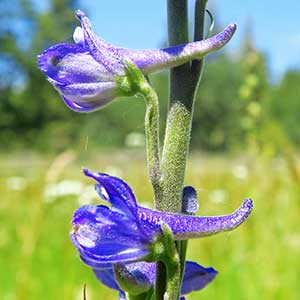Delphinium distichum
Delphinium menziesii
two-spike larkspur
Menzies larkspur
Basal and lower cauline leaves long-petiolate, the blades 4-6 cm. broad and divided nearly to the base into 3 segments, which are twice divided into broad segments; lower leaves abruptly transitional into mid-stem leaves, which are short-petiolate, very numerous and overlapping, and finely divided into linear segments.
Leaves mostly cauline, only the basal ones long-petiolate, the blades 3-7 cm. broad, 2-3 times dissected, the ultimate segments comparatively few, narrowly oblong.
Inflorescence a many-flowered, spike-like raceme, the pedicels shorter than the calyx spur and strongly ascending;
sepals 5, bluish-purple with lighter streaks, cupped forward, 7-9 mm long, oblong, the spur 11-17 mm. long;
petals 4, small, the lower pair blue, lobed, the upper pair white;
stamens numerous;
pistils 3.
Inflorescence simple to compound, the racemes 3-20 flowered, open and loose, the pedicels from sub-equal to the flowers to several times as long;
sepals 5, deep blue, 12-18 mm. long, the spur 13-15 mm. long, much longer than the upper sepal;
petals 4, small, the lower pair blue, lightly veined and shallowly notched, the upper pair white or light blue;
stamens numerous;
pistils 3.
Follicles 8-12 mm. long, erect, usually glandular.
Follicles 9-16 mm. long, erect to spreading, densely pubescent.
Delphinium distichum
Delphinium menziesii
- Local floras:
BC,
OR,
WA
- Local Web sites:
Flora NW,
PNW Herbaria
WildflowerSearch
iNaturalist (observations)
USDA Plants Database
- LBJ Wildflower Center
- SEINet
- Plants of the World Online
- Encyclopedia of Life
- Wikipedia
- Google Image Search



